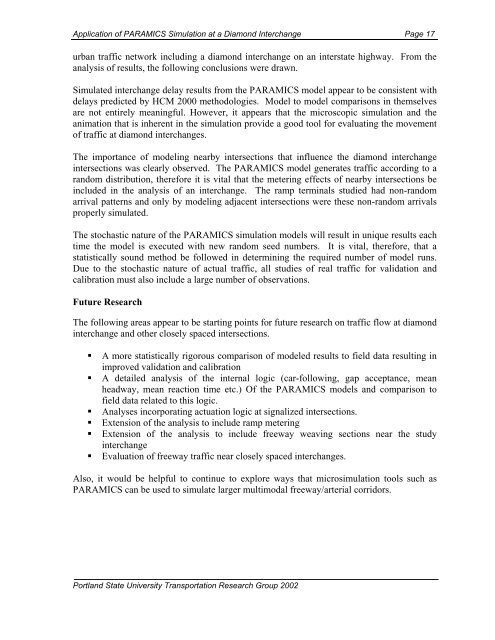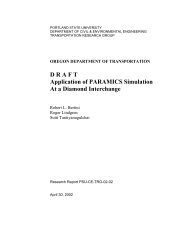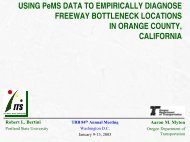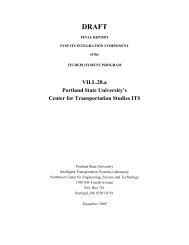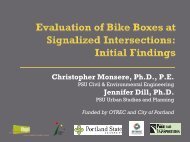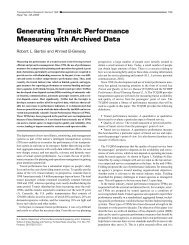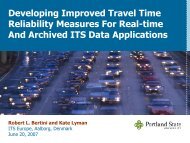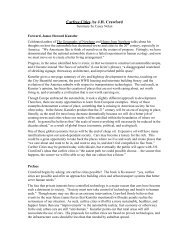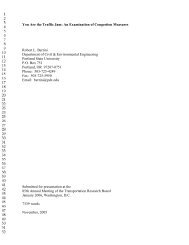Application of Paramics Simulation to a Diamond Interchange
Application of Paramics Simulation to a Diamond Interchange
Application of Paramics Simulation to a Diamond Interchange
You also want an ePaper? Increase the reach of your titles
YUMPU automatically turns print PDFs into web optimized ePapers that Google loves.
<strong>Application</strong> <strong>of</strong> PARAMICS <strong>Simulation</strong> at a <strong>Diamond</strong> <strong>Interchange</strong> Page 17<br />
urban traffic network including a diamond interchange on an interstate highway. From the<br />
analysis <strong>of</strong> results, the following conclusions were drawn.<br />
Simulated interchange delay results from the PARAMICS model appear <strong>to</strong> be consistent with<br />
delays predicted by HCM 2000 methodologies. Model <strong>to</strong> model comparisons in themselves<br />
are not entirely meaningful. However, it appears that the microscopic simulation and the<br />
animation that is inherent in the simulation provide a good <strong>to</strong>ol for evaluating the movement<br />
<strong>of</strong> traffic at diamond interchanges.<br />
The importance <strong>of</strong> modeling nearby intersections that influence the diamond interchange<br />
intersections was clearly observed. The PARAMICS model generates traffic according <strong>to</strong> a<br />
random distribution, therefore it is vital that the metering effects <strong>of</strong> nearby intersections be<br />
included in the analysis <strong>of</strong> an interchange. The ramp terminals studied had non-random<br />
arrival patterns and only by modeling adjacent intersections were these non-random arrivals<br />
properly simulated.<br />
The s<strong>to</strong>chastic nature <strong>of</strong> the PARAMICS simulation models will result in unique results each<br />
time the model is executed with new random seed numbers. It is vital, therefore, that a<br />
statistically sound method be followed in determining the required number <strong>of</strong> model runs.<br />
Due <strong>to</strong> the s<strong>to</strong>chastic nature <strong>of</strong> actual traffic, all studies <strong>of</strong> real traffic for validation and<br />
calibration must also include a large number <strong>of</strong> observations.<br />
Future Research<br />
The following areas appear <strong>to</strong> be starting points for future research on traffic flow at diamond<br />
interchange and other closely spaced intersections.<br />
• A more statistically rigorous comparison <strong>of</strong> modeled results <strong>to</strong> field data resulting in<br />
improved validation and calibration<br />
• A detailed analysis <strong>of</strong> the internal logic (car-following, gap acceptance, mean<br />
headway, mean reaction time etc.) Of the PARAMICS models and comparison <strong>to</strong><br />
field data related <strong>to</strong> this logic.<br />
• Analyses incorporating actuation logic at signalized intersections.<br />
• Extension <strong>of</strong> the analysis <strong>to</strong> include ramp metering<br />
• Extension <strong>of</strong> the analysis <strong>to</strong> include freeway weaving sections near the study<br />
interchange<br />
• Evaluation <strong>of</strong> freeway traffic near closely spaced interchanges.<br />
Also, it would be helpful <strong>to</strong> continue <strong>to</strong> explore ways that microsimulation <strong>to</strong>ols such as<br />
PARAMICS can be used <strong>to</strong> simulate larger multimodal freeway/arterial corridors.<br />
Portland State University Transportation Research Group 2002


